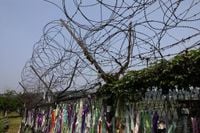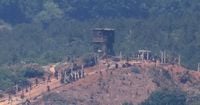On Sunday, October 19, 2025, a North Korean soldier made a daring and rare escape across the heavily fortified Demilitarized Zone (DMZ) into South Korea, according to statements from the South Korean Joint Chiefs of Staff reported by AP, Newsweek, and Reuters. The soldier was quickly taken into custody near the Military Demarcation Line (MDL), marking the first such military defection in more than a year and underscoring the ongoing tensions and risks along one of the world’s most dangerous borders.
The DMZ, a 248-kilometer-long and 4-kilometer-wide strip of land separating the two Koreas, is notorious for its dense forests, landmines, barbed wire, tank traps, and constant surveillance by troops on both sides. Despite its official name, the Demilitarized Zone is anything but peaceful—its reputation for danger is well earned. As Newsweek and AP both highlight, only a handful of defectors have ever attempted this direct route, with most choosing the comparatively less perilous journey through China.
The soldier’s successful crossing is not only remarkable for its rarity but also for the sheer peril involved. According to Hong Min, a senior analyst at the Korea Institute for National Unification who spoke to AFP, "The soldier's likely familiarity with the area may have helped him navigate the heavily mined terrain…. The latest crossing will not be received positively by Pyongyang, as he could provide the South with information on its troop movements and operations in the border area." This sentiment was echoed by defense ministry officials, who confirmed the soldier expressed a desire to resettle in South Korea and was being treated as a defector.
South Korea’s military tracked and monitored the individual as he approached the MDL, eventually securing him safely. As is standard procedure for arrivals from the North, the soldier was handed over to intelligence authorities for a thorough screening and investigation. The South Korean Ministry of Unification is now probing the circumstances surrounding the incident, with officials treating it as a clear case of defection, Newsweek reports.
While the North Korean regime has yet to comment publicly—despite Newsweek reaching out to the North Korean Embassy in Beijing—the response from Pyongyang is expected to be harsh. Defectors are routinely labeled as “human scum” and traitors, with severe punishments awaiting those caught attempting to flee. As Newsweek and AP note, defectors risk imprisonment, torture, or even death if captured by North Korean authorities, and their families can face collective punishment.
In context, this defection is part of a long and fraught history. Since the end of the Korean War in 1953 (which concluded with an armistice rather than a peace treaty, leaving the Koreas technically still at war), more than 34,000 North Koreans have escaped to the South. However, the vast majority—over 99%—have taken the indirect route via China, often with the help of smugglers and underground networks. Only a tiny fraction have braved the direct crossing of the DMZ, and even fewer have done so as members of the North Korean military.
According to official data cited by Newsweek and AP, South Korea recorded 236 defections from the North in 2024, with women comprising the majority. Of these, only three involved direct border crossings. In the first half of 2025, South Korea received 96 defectors, including 88 women and eight men. The rarity of such military defections is underscored by the fact that the last reported incident occurred in August 2024, when a North Korean staff sergeant fled across the border’s eastern section.
The DMZ itself remains an intimidating obstacle. Defectors face not only landmines and barbed wire but also the constant threat of sniper fire and immediate retaliation. The Associated Press recalls a dramatic 2017 incident, when a fleeing North Korean soldier was shot at more than three dozen times by his own comrades before South Korean troops managed to drag him to safety. Since then, North Korea has reportedly reinforced its side of the border with anti-tank barriers and other fortifications, a move that coincides with Kim Jong Un’s recent decision to abandon the regime’s decades-long goal of reunification with the South.
The timing of this latest defection is especially significant, coming just months after South Korean President Lee Jae Myung took office in June 2025. President Lee has pledged a softer, more conciliatory approach to Pyongyang, a marked departure from his predecessor’s hardline stance. Concrete gestures have included suspending propaganda broadcasts across the border, a move that Seoul says North Korea reciprocated. However, North Korean officials, including Kim Jong Un’s influential sister Kim Yo Jong, have publicly dismissed these overtures as a “pipe dream.” Relations between the two Koreas remain deeply strained, with both sides maintaining heavy military presences along the border and regularly exchanging harsh rhetoric.
For South Korea, the defection presents both an intelligence opportunity and a diplomatic challenge. The soldier could provide valuable insights into North Korean troop deployments, border operations, and internal morale—information that Seoul’s intelligence agencies will undoubtedly scrutinize closely. At the same time, such high-profile defections tend to inflame tensions with Pyongyang, which views them as a direct affront to the regime’s authority and a potential security risk.
Despite the risks, the continued trickle of defectors—whether through China or, in rare cases, across the DMZ—reflects the desperation and determination of North Koreans seeking greater freedom and opportunity. As Newsweek points out, tens of thousands have risked everything to escape the tightly controlled, repressive environment of Kim Jong Un’s regime in search of political and economic liberty in the South.
As investigations into the latest defection continue, it remains to be seen whether the number of North Korean defectors will rise or fall in the coming months. What’s clear is that the border dividing the Korean Peninsula, though heavily guarded and fraught with danger, remains a potent symbol of both division and the enduring human desire for freedom.
This rare and perilous crossing is a stark reminder of the ongoing risks faced by those who dare to flee North Korea, and of the persistent tensions that define life along the world’s last Cold War frontier.

